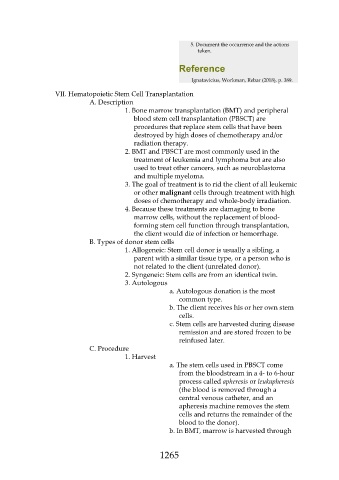Page 1265 - Saunders Comprehensive Review For NCLEX-RN
P. 1265
5. Document the occurrence and the actions
taken.
Reference
Ignatavicius, Workman, Rebar (2018), p. 389.
VII. Hematopoietic Stem Cell Transplantation
A. Description
1. Bone marrow transplantation (BMT) and peripheral
blood stem cell transplantation (PBSCT) are
procedures that replace stem cells that have been
destroyed by high doses of chemotherapy and/or
radiation therapy.
2. BMT and PBSCT are most commonly used in the
treatment of leukemia and lymphoma but are also
used to treat other cancers, such as neuroblastoma
and multiple myeloma.
3. The goal of treatment is to rid the client of all leukemic
or other malignant cells through treatment with high
doses of chemotherapy and whole-body irradiation.
4. Because these treatments are damaging to bone
marrow cells, without the replacement of blood-
forming stem cell function through transplantation,
the client would die of infection or hemorrhage.
B. Types of donor stem cells
1. Allogeneic: Stem cell donor is usually a sibling, a
parent with a similar tissue type, or a person who is
not related to the client (unrelated donor).
2. Syngeneic: Stem cells are from an identical twin.
3. Autologous
a. Autologous donation is the most
common type.
b. The client receives his or her own stem
cells.
c. Stem cells are harvested during disease
remission and are stored frozen to be
reinfused later.
C. Procedure
1. Harvest
a. The stem cells used in PBSCT come
from the bloodstream in a 4- to 6-hour
process called apheresis or leukapheresis
(the blood is removed through a
central venous catheter, and an
apheresis machine removes the stem
cells and returns the remainder of the
blood to the donor).
b. In BMT, marrow is harvested through
1265

